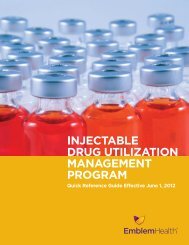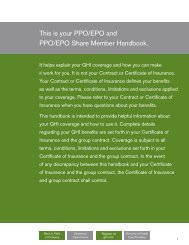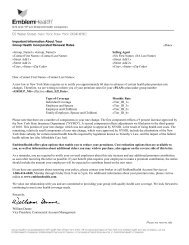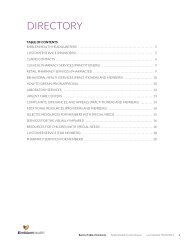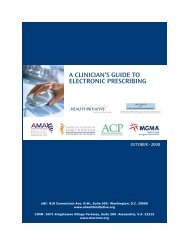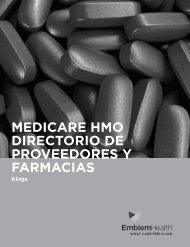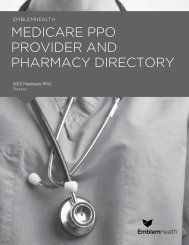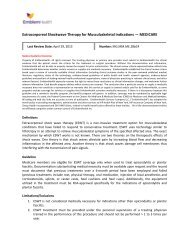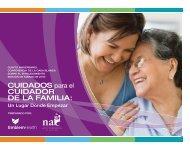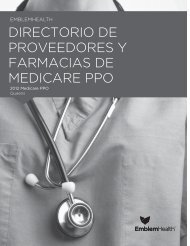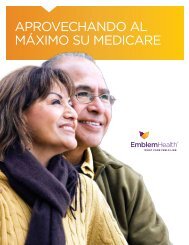PPO II - EmblemHealth
PPO II - EmblemHealth
PPO II - EmblemHealth
You also want an ePaper? Increase the reach of your titles
YUMPU automatically turns print PDFs into web optimized ePapers that Google loves.
38<br />
2013 Evidence of Coverage for <strong>PPO</strong> <strong>II</strong><br />
Chapter 3. 3: Using the plan’s coverage for your medical services<br />
• As soon as possible, make sure that our plan has been told about your emergency. We need to<br />
follow up on your emergency care. You or someone else should call to tell us about your emergency<br />
care, usually within 48 hours. Call the number on the back of your membership card.<br />
What is covered if you have a medical emergency?<br />
You may get covered emergency medical care whenever you need it, anywhere in the United States or its<br />
territories. Our plan covers ambulance services in situations where getting to the emergency room in any<br />
other way could endanger your health. For more information, see the Medical Benefi ts Chart in Chapter<br />
4 of this booklet.<br />
Our plan covers emergency medical care anywhere in the world. Please see the benefi t chart in Chapter<br />
4 for details.<br />
If you have an emergency, we will talk with the doctors who are giving you emergency care to help<br />
manage and follow up on your care. Th e doctors who are giving you emergency care will decide when<br />
your condition is stable and the medical emergency is over.<br />
After the emergency is over you are entitled to follow-up care to be sure your condition continues to be<br />
stable. Your follow-up care will be covered by our plan. If you get follow-up care from out-of-network<br />
providers, you will pay the higher out-of-network cost sharing.<br />
What if it wasn’t a medical emergency?<br />
Sometimes it can be hard to know if you have a medical emergency. For example, you might go in for<br />
emergency care – thinking that your health is in serious danger – and the doctor may say that it wasn’t<br />
a medical emergency after all. If it turns out that it was not an emergency, as long as you reasonably<br />
thought your health was in serious danger, we will cover your care.<br />
However, after the doctor has said that it was not an emergency, the amount of cost sharing that you pay<br />
will depend on whether you get the care from network providers or out-of-network providers. If you<br />
get the care from network providers, your share of the costs will usually be lower than if you get the care<br />
from out-of-network providers.<br />
Section 3.2 Getting care when you have an urgent need for care<br />
What is “urgently needed care”?<br />
“Urgently needed care” is a non-emergency, unforeseen medical illness, injury, or condition, that requires<br />
immediate medical care. Urgently needed care may be furnished by in-network providers or by out-ofnetwork<br />
providers when network providers are temporarily unavailable or inaccessible. Th e unforeseen<br />
condition could, for example, be an unforeseen fl are-up of a known condition that you have.<br />
What if you are in the plan’s service area when you have an urgent need for care?<br />
In most situations, if you are in the plan’s service area and you use an out-of-network provider, you will<br />
pay a higher share of the costs for your care. However, if the circumstances are unusual or extraordinary,<br />
and network providers are temporarily unavailable or inaccessible, we will allow you to get covered<br />
services from an out-of-network provider at the lower in-network cost-sharing amount.



